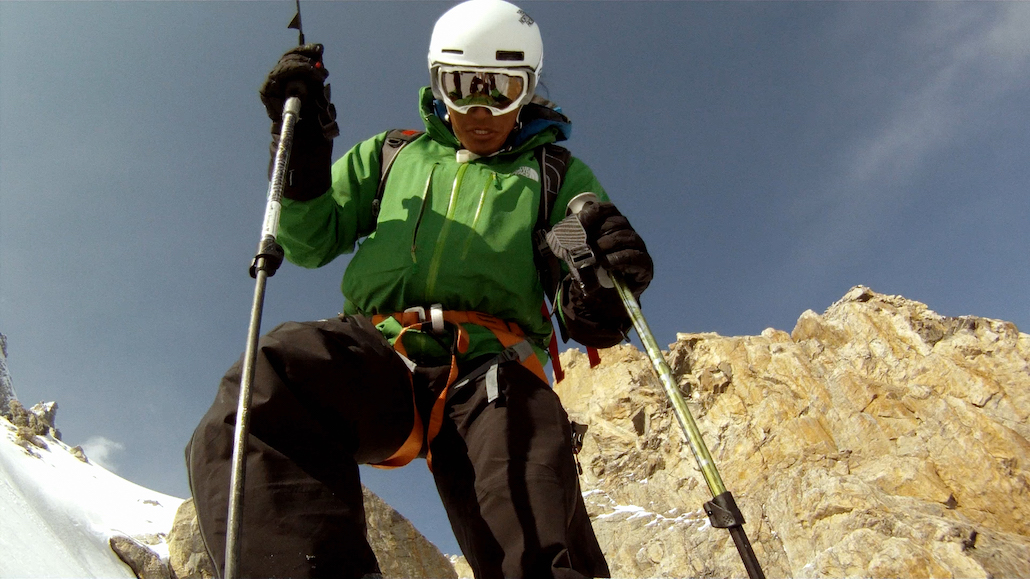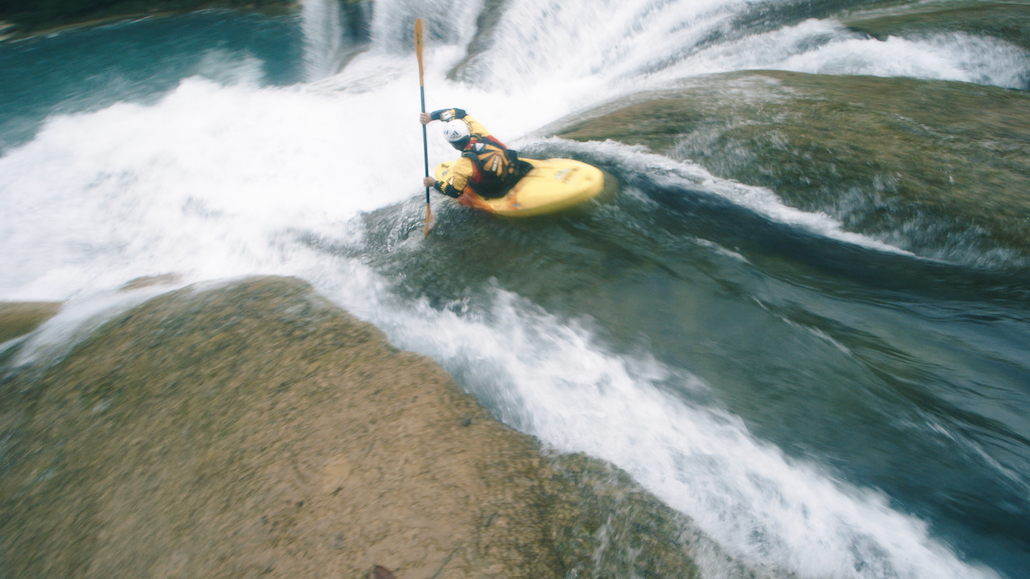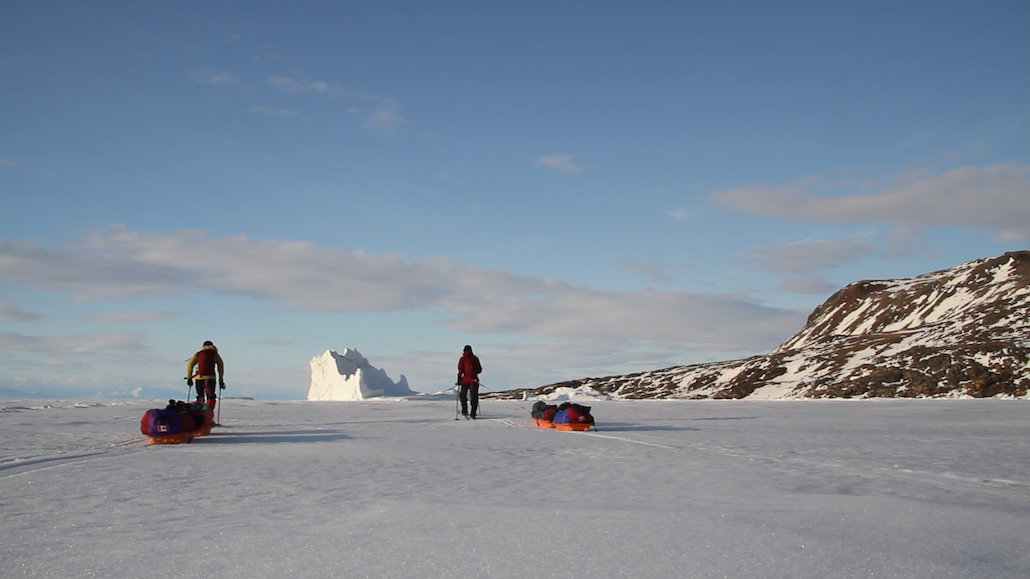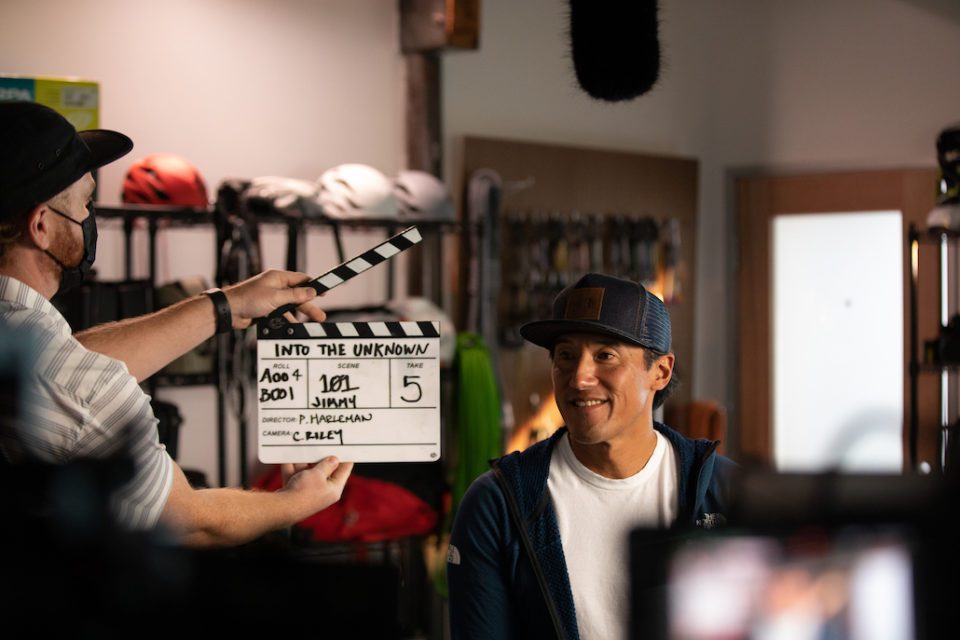Buckle in, everyone. Filmmakers E. Chai Vasarhelyi and Jimmy Chin have a new 10-part series examining the most harrowing moments of A-List adventure athletes, and how they come back stronger from mountain avalanches, big-wave beatdowns, high-altitude heart attacks and, in one case, clinical death.
It’s a subject ripe for hyperbole, but in the hands of the Academy Award-winning duo behind Free Solo and Meru, it’s a revealing look inside the minds of elite climbers, freeskiers, surfers and whitewater boaters. Much of the footage will be familiar to mountain-sports fans. The series revisits gorgeous big-mountain lines by freeskier Angel Collinson and snowboarding legend Travis Rice, and travels with climber Alex Honnold to Morocco’s High Atlas Mountains to prepare for his history-making free-solo ascent of El Capitan. It follows kayaker Gerd Serrasolses and crew as they huck massive travertine waterfalls for the 2015 River Roots classic Chasing Niagara.
What’s novel is the filmmakers’ probing interviews about the scariest moments in the athletes’ lives, many of them shared in visceral point-of-view footage. When a 50-foot waterfall plunge goes terribly wrong for Serrasolses, we watch through his helmet cam as Rush Surges and a wild-eyed Evan Garcia pump him back to life (everyone please renew your CPR certs – Eds).
In another episode, kayakers Ben Stookesberry and Chris Korbulic cope with the emotional toll of losing a friend, whitewater explorer Hendri Coetzee, to a man-eating croc. How does a person go through something like that, or survive a widow-maker heart attack 22,000 feet up a Himalayan peak, as Chin’s good friend and climbing partner does in the fourth episode, and carry on adventuring?
We put the question to Chin, who addresses the question as interviewer, series narrator and the subject of an episode recounting his own experience with a class four avalanche in the Teton backcountry. Edge of the Unknown With Jimmy Chin is streaming on National Geographic and Disney+.
“Mr. Chin is ready for his close up.” Photo: National Geographic/Teague Wasserman
Adventure Journal: How did this series come about?
Jimmy Chin: We first conceived of it during the early part of Covid. I was being asked by all these different people to talk about what I had learned from my most consequential and trying moments, that I might be able to share with people who are feeling isolated and facing the unknown. I had a lot of personal anecdotes in my life that fit that category, but I started to really think about a lot of my friends and athletes I knew who had a particular way of looking at the world, which I thought was useful in a conversation about survival, and finding opportunity in what most people would consider very dire circumstances.
I knew a lot of these stories already and the athletes were people that I looked up to and admired. I started thinking about a series, as as it kept evolving it became about the most elite athletes — I mean, if you look at this roster, it’s the best of the best in each of their sports – and we wanted to really explore some of the most challenging and consequential moments in their careers. And in exploring those moments, we get a sense of who they are and what they face on a day-to-day basis.
One of the episodes explores your own close call with a huge avalanche. In exploring these crux moments other athletes have experienced, did you naturally see them through the lens of your avalanche?
Yeah, I did. That moment in my career was it was very hard for me to talk about. It was a very vulnerable moment for me, particularly because I had felt so invincible. And then this thing happened to me where it was very clear that I was fallible and that what I was doing did have consequences.

Jimmy Chin in the Teton backcountry. An avalanche there in 2011 nearly killed him. Photo: Jimmy Chin Productions)
I’d always thought it won’t happen to me, that I’m conservative enough and calculated enough. I didn’t necessarily say that out loud, but that’s something that I think all of these athletes have experienced, when you’re on your game and you have these transcendent moments and it’s incredible. Then, when things go wrong, they go wrong pretty quickly. When you experience something like that, you have to be so intentional about going back to these sports. And I think it shows the level of passion and commitment these athletes have for what they do.
I knew that these moments would be hard for the athletes to talk about. It’s a part of the world that we inhabit that is often overlooked, and we don’t actually examine very much. We don’t turn the stone over to look underneath, into that particular space. I just felt it was an important place, and the stories about how they manage it are really inspiring. It also humanizes people and shows that these are real people who have to make hard choices.
Was it was tough for you to turn over that rock for the episode that focused on your avalanche experience?
It was. I was asking all of these athletes to do it, and I felt that if I was asking them to do it, then I should also show up too. And I’m very, very grateful that all these athletes gave us access to these stories, and were willing to talk about these stories and trust us with those stories, because a lot of them are very sensitive. They trusted us.

Gerd Serrasolses, over the edge in Chiapas. Photo: Rush Sturges / River Roots Productions
I suspect some of that comes from you having been in that place yourself.
For sure. I think people agreed to work with us, and they trusted us, because they know that we are sensitive to what these experiences are like. We pride ourselves in keeping things real and authentic, and with an insider’s point of view that hopefully broadens people’s perception of who these athletes are and what they do. That’s ultimately what we were trying to achieve.
Which of the episodes affected you the most personally?
Gerd’s story was very intense. And I think Ben Stookesberry’s piece was personally very difficult. Honestly, there were some hard ones, and I know I’m doing something interesting when they’re that difficult — when there are so many sensitivities around these stories, and we’re trying to get it right because it’s so nuanced. We put a lot of time to trying to make sure that we were respectful of these stories and sensitive to all the little elements that make it authentic and honest and truthful. It’s really important to me and Chai that the stories are true to the spirit of what happened, and what people came away with.
I would have guessed Conrad Anker’s, because it really got me, and I know your history together. I could feel the love and heartache coming through the screen.
Conrad’s story . . . a lot of them were very challenging, and I kept thinking, couldn’t I have picked an easier story?

Sarah-McNair Landry and Erik McNair-Landry walk the final stretch across the Northwest Passage. Photo: National Geographic /Sarah McNair-Landry
I think Conrad’s episode affected me because it was about loss. It touched on the loss that both you and he have experienced with the death of friends in the mountains, but it also seemed that after his heart attack Conrad was facing down the end of his career in the high mountains—the end of the thing that has given him so much joy.
It’s kind of funny, though. Not funny, but Conrad after his heart attack went to Antarctica. He met up with me, Jim Morrison and Hilaree Nelson, and we put in one of the biggest mountain days I’ve ever had. We climbed Vinson, the highest peak in Antarctica, from the base to the top. We did the second ascent of the route that he put up 20 years ago, the Ice Stream. Nobody’s done it since he put it up 20 years ago. It was a 10,000-foot day in knee- to thigh-deep snow, carrying our skis. Bottom to top in a single push, and we were at Vinson for less than 48 hours. Some people spend two weeks or a month there, and Conrad — it’s like, yeah, he has put it aside. But what he considers as putting it aside is, for most people, just insane. I was like, ‘Should you be doing this, Conrad? Because I’m dying.’The opening voiceover seems to be kind of a thesis of the series. “In the pivotal moments when life hangs in the balance, what drives the greatest to continue pushing to redefine what is humanly possible, to stare down fear and risk it all?”
Did you find an answer, a common thread shared between these ten athletes, and ten experiences?
Ultimately it’s an examination of why. And it’s really not a common thread as a statement, but more of a common thread as a question. What are you willing to risk and sacrifice to experience these transcendent moments? Because that is the question that everybody is weighing. Especially at that level, at that point in each of these athletes’ careers, that question is something that lurks.
And you’re examining that episode in their careers, in their life, where that question is being asked the loudest.
Where it’s hanging in the balance. Because in examining that, you understand their motivations.
Top photo: Alex Honnold free soloing “Heaven” in Yosemite National Park. Photo: National Geographic


1 comment
Alizabella Rackoff